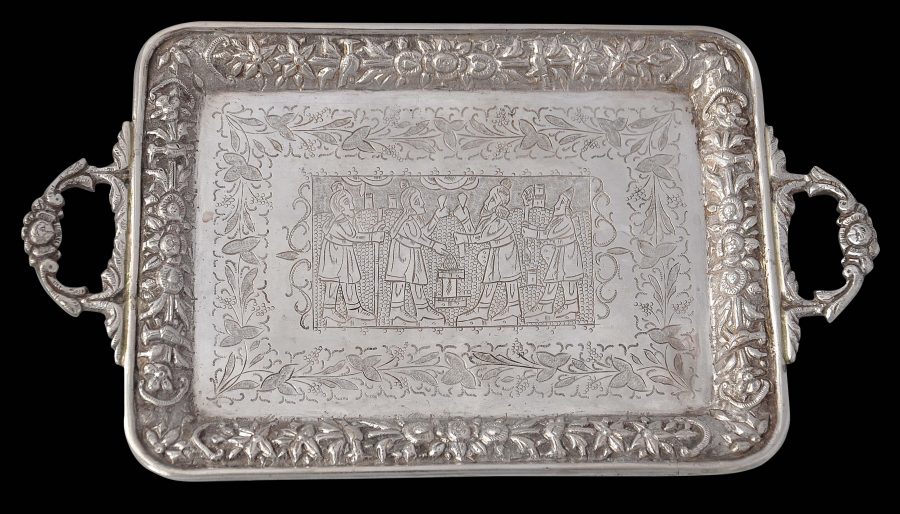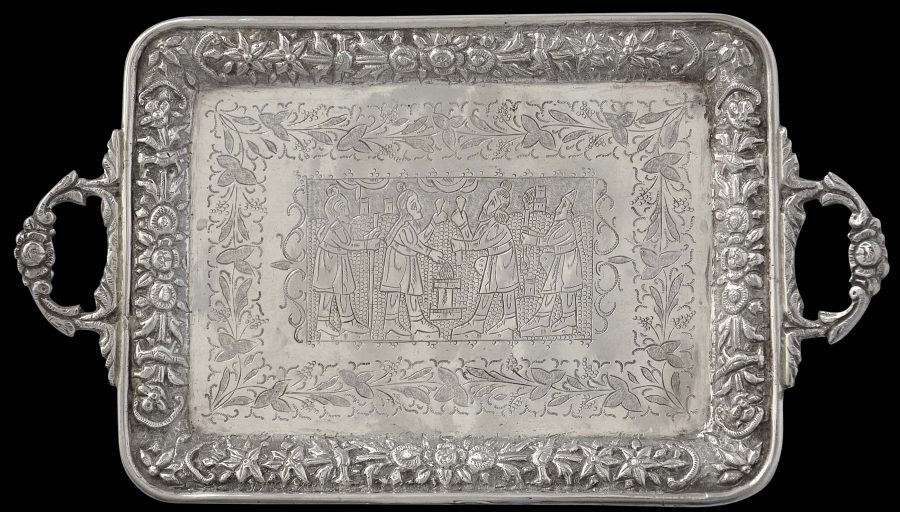Enquiry about object: 1711
Indian Parsee (Parsi) Engraved Silver Tray
Parsee Community, Bombay, India circa 1900
length: 22.7cm, width: 12.8cm, weight: 227g
Provenance
UK art market
This small, elegant tray of solid, unusually high-grade silver has cast floral handles and a raised border repoussed and chased with similar flower motifs. The centre of the tray is engraved with a scene showing four Parsee or Zoroastrian priests attending the sacred fire in a Fire Temple, all within an engraved floral border.
It is likely that such a tray was used in conjunction with the silver ses, a set of implements including dishes, rosewater sprinklers and so on used as part of the Parsee coming-of age (Navjote) and wedding rituals.
By the early twentieth century, there were three main Parsee silver shops in Bombay that specialised in making Parsee-themed ritual items for the local community. Many other silver items were imported from southern China where silversmiths made items for export worldwide (Cama, 1998). Most probably, this tray was the product of Bombay-based Parsee silversmiths.
The tray is in superb condition. It is heavy for its size and the purity of the silver used is noticeable.
Parsees subscribe to Zoroastrianism, one of the world’s oldest living religions. Darius was crowned king of Persia in 522 BC, and was the first of the Achaemenid kings to be confirmed as a true follower of Zoroaster. Ahura Mazda, proclaimed by Zoroaster as God, was mentioned and celebrated as Creator in many of Darius’ speeches.
Under the kings of the Achaemenian line, the religion became one of the great religions of the ancient East. But it shared the fate of the Persian monarchy, it was shattered, though not overthrown, by the conquest of Alexander and it fell into neglect. With the Arab conquest in the seventh century came Islam and Zoroastrianism was vigorously repressed. A group of Zoroastrians fled in 936AD to Gujurat in India. By the seventeenth century, most had moved to Bombay, with smaller communities in Karachi and Rangoon. (Later small communities existed in Singapore and Hong Kong.) The Bombay community today is the world’s largest, far exceeding the relative handful of Zoroastrians that remain in Iran.
Zoroastrianism teaches the importance of the elements, particularly fire. Zoroastrian pilgrims had for example come from Persia during the Middle Ages onwards to erect temples and worship the then mysterious fire that shot out of the earth in certain parts of Azerbaijan, fuelled by underground wells of natural gas. A belief in the existence of angels is another important Parsee belief. Angels guide individuals and events – hence the use of angel motifs on this vase for example.
Each Parsee fire temple has a central, sacred flame that is never allowed to go out. (Mumbai has around fifty fire temples.) As mentioned, traditionally, the bodies of dead Parsees are laid out in so called ‘Towers of Silence’ and crows are then allowed to feed on them. Cremation would ‘pollute’ fire and burial would ‘pollute’ the earth. In Mumbai, the principal Towers of Silence are adjacent to city’s so-called ‘Hanging Gardens’.
Today, probably there are fewer than 140,000 Parsees or Zoroastrians worldwide. About 80,000 live in Mumbai (Bombay), a city of 14 million people. Another 6,000 live in Karachi in Pakistan.
Like Europe’s Jewish communities or the Chinese of Southeast Asia, the Parsees of India and Pakistan are a distinct but exceptionally successful commercial minority. By the nineteenth century, Bombay’s Parsee families dominated the city’s commercial sector, particularly in spinning and dyeing and banking.
Wealth from these activities was put into property so that by 1855, it was estimated that Parsee families owned about half of the island of Bombay. Today, India’s most prominent Parsee family is the Tata Family, founders and owners of India’s most prominent conglomerate the Tata Group.
In Burma, Parsees were involved in trading and financing too. Some were awarded ruby mining concessions in upper Burma.
Well off though they are as a community, the Parsees are dying out. It has been estimated that a thousand Parsees die each year in Mumbai, but only 300- 400 are born. Today, one in five Mumbai Parsees is aged 65 or more. In 1901 the figure was one in fifty. Low birth rates are the main factor. Probably no Parsees remain in Burma today.
Nonetheless, many vestiges of the Parsees’ contribution to commerce in South and East Asia remain. Apart from India’s giant Tata Group, smaller examples can be seen: small change offices in Hong Kong are known locally as ‘schroffs’ after a common Parsee surname, and in Singapore the road that runs alongside that country’s finance ministry is known as Parsi Road.
References
Cama, S., ‘Parsi crafts: Gifts from Magi’, UNESCO Power of Creativity Magazine, Vol. 2, August 2008.
Framjee, D., The Parsees: Their History, Manners, Customs and Religion, Asian Education Services, 2006 (first published in 1858.)
Godrej, P.J. & F. Punthakey Mistree, A Zoroastrian Tapestry: Art, Religion & Culture, Mapin Publishing, 2002.



